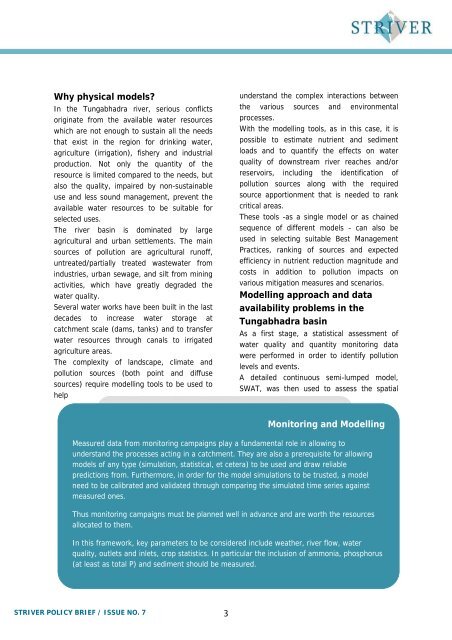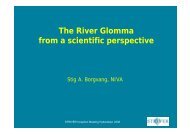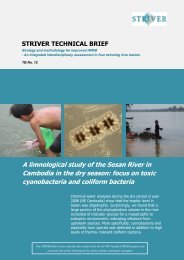r - NIVA
r - NIVA
r - NIVA
Create successful ePaper yourself
Turn your PDF publications into a flip-book with our unique Google optimized e-Paper software.
Why physical models?In the Tungabhadra river, serious conflictsoriginate from the available water resourceswhich are not enough to sustain all the needsthat exist in the region for drinking water,agriculture (irrigation), fishery and industrialproduction. Not only the quantity of theresource is limited compared to the needs, butalso the quality, impaired by non-sustainableuse and less sound management, prevent theavailable water resources to be suitable forselected uses.The river basin is dominated by largeagricultural and urban settlements. The mainsources of pollution are agricultural runoff,untreated/partially treated wastewater fromindustries, urban sewage, and silt from miningactivities, which have greatly degraded thewater quality.Several water works have been built in the lastdecades to increase water storage atcatchment scale (dams, tanks) and to transferwater resources through canals to irrigatedagriculture areas.The complexity of landscape, climate andpollution sources (both point and diffusesources) require modelling tools to be used tohelpunderstand the complex interactions betweenthe various sources and environmentalprocesses.With the modelling tools, as in this case, it ispossible to estimate nutrient and sedimentloads and to quantify the effects on waterquality of downstream river reaches and/orreservoirs, including the identification ofpollution sources along with the requiredsource apportionment that is needed to rankcritical areas.These tools -as a single model or as chainedsequence of different models - can also beused in selecting suitable Best ManagementPractices, ranking of sources and expectedefficiency in nutrient reduction magnitude andcosts in addition to pollution impacts onvarious mitigation measures and scenarios.Modelling approach and dataavailability problems in theTungabhadra basinAs a first stage, a statistical assessment ofwater quality and quantity monitoring datawere performed in order to identify pollutionlevels and events.A detailed continuous semi-lumped model,SWAT, was then used to assess the spatialMonitoring and ModellingMeasured data from monitoring campaigns play a fundamental role in allowing tounderstand the processes acting in a catchment. They are also a prerequisite for allowingmodels of any type (simulation, statistical, et cetera) to be used and draw reliablepredictions from. Furthermore, in order for the model simulations to be trusted, a modelneed to be calibrated and validated through comparing the simulated time series againstmeasured ones.Thus monitoring campaigns must be planned well in advance and are worth the resourcesallocated to them.In this framework, key parameters to be considered include weather, river flow, waterquality, outlets and inlets, crop statistics. In particular the inclusion of ammonia, phosphorus(at least as total P) and sediment should be measured.STRIVER POLICY BRIEF / ISSUE NO. 7 3





